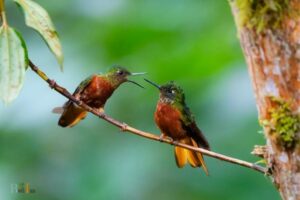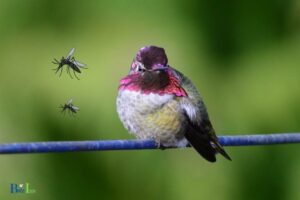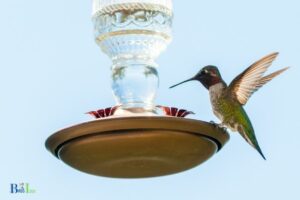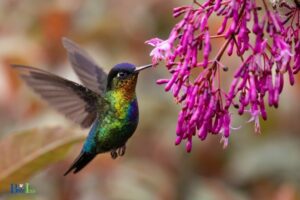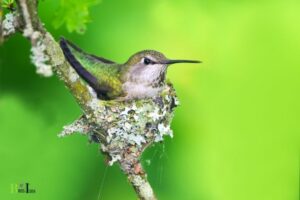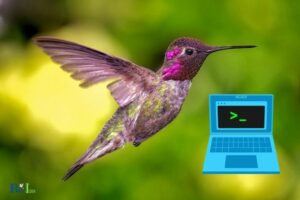Where Do Anna’s Hummingbirds Nest: Trees or Shrubs!
Anna’s hummingbirds (Calypte anna) typically build their nests in trees or shrubs, often in areas with dense foliage, at heights ranging from 6 to 20 feet above the ground.
Anna’s hummingbirds are native to the western coastal regions of North America, from Alaska to Baja California.
These birds are known for their strong territorial instincts and will defend their nesting sites vigorously.
They choose nesting locations that provide adequate cover from predators and weather, as well as a reliable food source nearby.
Anna’s hummingbirds are known for their intricate nest-building skills, often using spider silk to create a flexible and secure structure.
The nests are small and cup-shaped, built with a combination of plant material, lichen, and feathers.
The female bird is responsible for constructing the nest, which usually takes about one to two weeks to complete.
Once the nest is ready, the female will lay one to three eggs, which she will incubate for approximately 16 days before the chicks hatch.
5 Locations and Habitats of Anna’s Hummingbirds Nests
| Habitat | Nest Location | Nest Height | Nest Materials |
| Forests | Shrubs | 5-15 feet | Plant fibers, feathers, spider silk |
| Gardens | Trees | 5-15 feet | Plant fibers, feathers, spider silk |
| Parks | Bushes | 5-15 feet | Plant fibers, feathers, spider silk |
| Coastal areas | Dense vegetation | 5-15 feet | Plant fibers, feathers, spider silk |
| Chaparral | Branches | 5-15 feet | Plant fibers, feathers, spider silk |
Key Takeaway
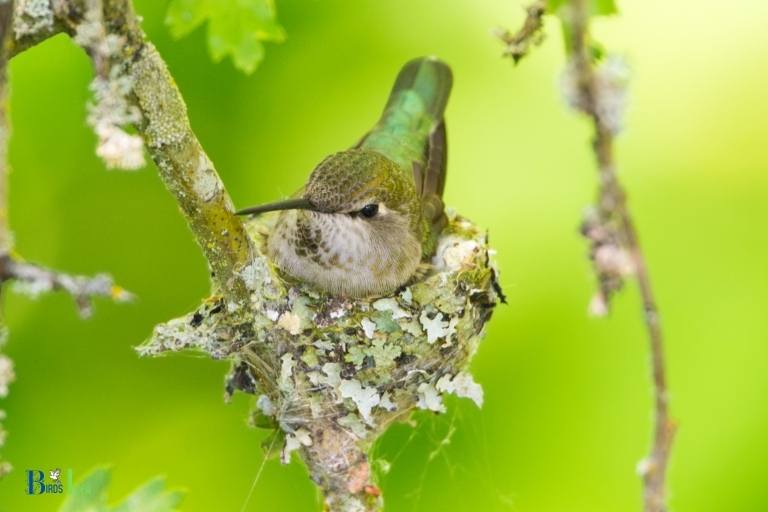
Five Facts About: Anna’s Hummingbirds Nesting Habits
Habitat And Nesting Behavior
Anna’s hummingbirds are one of the most stunning bird species that inhabit the western coast of north america. These tiny wonders boast beautiful iridescent green and pink feathers and are known for their unique and recognizable chirping sound.
If you’re an avid bird watcher or simply a nature enthusiast, you may be curious about where these fascinating creatures build their nests.
In this blog post, we’ll be exploring the habitat and nesting behavior of anna’s hummingbirds.
Anna’s hummingbirds prefer to live in environments with mild temperatures and abundant plant life.
These birds can be commonly found in california, arizona, and parts of nevada, but they have also been spotted as far north as british columbia and alaska.
Here are some more key points to keep in mind when it comes to anna’s hummingbirds’ habitat:
- These birds are attracted to flowering plants such as salvia, mimosa, and fuchsia.
- They prefer both natural and artificial sources of nectar, such as hummingbird feeders, to supplement their diet.
- Anna’s hummingbirds also require a source of clean water to drink and bathe in, such as a birdbath or fountain.
When it comes to nesting behavior, anna’s hummingbirds build their nests in a unique and fascinating way.
Here are some key points regarding nest location and construction:
- Anna’s hummingbirds prefer to build their nests on sturdy branches that can support the weight of their tiny nests.
- Their nests are typically located between 6 and 30 feet above the ground, in areas that are protected from the wind and rain.
- Anna’s hummingbirds’ nests are small and cup-shaped, typically measuring only 1.5 inches in diameter.
- They are constructed using materials such as spiderwebs, plant down, and small twigs, and oftentimes, bits of lichen, moss, or bark are added to the exterior of the nest, making it virtually indistinguishable from the surrounding environment.
Learning about the nesting behavior and habitat of anna’s hummingbirds can be a fascinating and rewarding experience for anyone interested in nature and wildlife.
By creating an environment that is hospitable to these tiny creatures, you can help ensure that they will continue to thrive for years to come.
Nesting Materials And Design
Types Of Materials Used To Construct Anna’S Hummingbird Nests
Anna’s hummingbirds are small birds, so it’s no surprise that their nests are tiny too.
Here’s a rundown of the materials they use to construct their nests:
- Lichens, mosses, and small leaves create the base of the nest. These materials are woven together using spider silk, which acts as a strong adhesive.
- The top layer of the nest is made of soft plant fibers, feathers, and hair.
As these hummingbirds build their nests in a wide range of areas, suitable nesting materials can vary. They’re known to use soft, insulating materials that can hold additional warmth and moisture, insulating the eggs from the cold.
Unique Design Features Of Anna’S Hummingbird Nests
Anna’s hummingbirds build intricate nests, varying slightly depending on where they’ve constructed them.
Here are some standout design features:
- Hinged lid design: These birds create an entrance at the top of their nests to keep their young safe from predators. A hinged lid of sorts allows the mother bird to quickly and easily access the nest beneath her.
- Stretchy walls: Hummingbirds need to be able to stretch their nest to accommodate their growing young. The spider silk used in the construction of the nest enables it to easily expand.
- Cup shape: A cup-shaped nest is necessary to keep the eggs in place, safe from harm. The lichen, moss, and spider silk utilized in the nest’s construction provide a snug, secure fit for the newly laid eggs.
Nesting Season And Timing
Where Do Anna’S Hummingbirds Nest: Nesting Season And Timing
Spring is the perfect season for birdwatchers, as birds are actively looking for a place to nest. Anna’s hummingbirds are one of the many bird species that start their nesting season during this time, with timing playing a crucial role in how they behave.
Here’s a closer look at the nesting season of anna’s hummingbirds and how timing affects their nesting behavior.
Overview Of The Nesting Season For Anna’S Hummingbirds:
- Anna’s hummingbirds usually start nesting in late winter or early spring, with the peak nesting season ending by mid-summer.
- These birds are known for building their nests using a variety of materials, including plant down, feathers, and spider webs, and they often choose high perches, such as tree branches or man-made structures, to nest.
- During the nesting season, female anna’s hummingbirds will lay up to four eggs, and both male and female will take turns incubating the eggs and feeding the chicks once they hatch.
Discussion Of How Timing Affects Nesting Behavior:
- Anna’s hummingbirds typically follow a set timing for nesting, which is influenced by daylight hours and weather conditions. Longer daylight hours trigger breeding behavior, and milder temperatures provide better nesting conditions.
- The timing of a hummingbird’s nesting season can also impact its breeding success. Early-season nesting pairs may face fewer predators and more abundant resources, while later nesting pairs may have a harder time finding enough food for their young and protecting them from predators.
- Climate change can also influence the timing of the nesting season for anna’s hummingbirds, as warmer spring temperatures can cause earlier onset of breeding behavior. However, changes in timing can have negative consequences for both nesting success and survival.
Overall, the nesting behavior of anna’s hummingbirds is a complex process that is heavily influenced by timing.
By understanding the nesting season and how it affects hummingbirds, birdwatchers can gain a deeper appreciation for these fascinating creatures’ reproductive habits.
Predators And Threats To Nesting
Anna’s hummingbirds are known for their vibrant and beautiful feathers, making them a charming sight to behold. However, as tiny birds with delicate bodies, they are vulneerable to predation and environmental threats, which could compromise their nesting success.
We’ll delve into the common predators and environmental threats that affect the nesting of anna’s hummingbirds.
Identification Of Common Predators Of Anna’S Hummingbird Nests
Predators of anna’s hummingbird nests come from both the animal kingdom and insect world.
They include:
- Snakes: Some snake species are known to climb trees and feed on hummingbird eggs and the young. The most common snake species that preys on hummingbirds include the coachwhip snake, rat snake, and gopher snake.
- Squirrels: Tree squirrels are known to be notorious nest predators, and anna’s hummingbirds are no exception. They could chew on nesting materials or destroy nests to get to the eggs or young.
- Raccoons: These omnivorous creatures are expert climbers and quick to discover nests. They often feed on the young and eggs of anna’s hummingbirds.
- Insects: Insect predators such as ants and wasps feed on hummingbird eggs and the young hummingbirds. They could easily fit through the small openings in anna’s hummingbird nests and wreak havoc.
Explanation Of Environmental Threats To Nesting Anna’S Hummingbirds
Apart from predation, anna’s hummingbirds face a variety of environmental threats that could affect their nesting success.
Environmental threats include:
- Nest destruction: Environmental factors such as harsh weather conditions, strong winds, and falling branches can damage nests.
- Climate change: Changes in climate can lead to uncertain weather patterns, which could interfere with breeding seasons or reduce the availability of food sources, directly affecting the nesting of anna’s hummingbirds.
- Habitat loss: The destruction and fragmentation of natural habitats can lead to reduced breeding grounds and food sources, forcing anna’s hummingbirds to nest in suboptimal locations.
- Pesticide use: The use of pesticides can contaminate food sources and poison hummingbirds, causing illness or death. Additionally, pesticides could also reduce the availability of insects, which make up a significant part of their diet.
Understanding the common predators and environmental threats that anna’s hummingbirds face is crucial in helping preserve this beautiful bird species.
By making necessary adaptations and changes, we can protect their breeding grounds and guarantee a future for these winged wonders.
FAQ Of Where Do Anna’S Hummingbirds Nest
How Do I Attract Anna’S Hummingbirds To My Backyard?
What Kind Of Trees Do Anna’S Hummingbirds Prefer To Nest In?
How Can I Identify Anna’S Hummingbirds?
When Is The Breeding Season For Anna’S Hummingbirds?
How Long Does It Take For Anna’S Hummingbirds To Incubate Their Eggs?
Conclusion
Anna’s hummingbirds have a special place in everyone’s heart, thanks to their vibrant feathers and sweet chirping. Their ability to build a nest in unconventional places such as branches, twigs, and even clotheslines, is fascinating.
However, their preference for plant types and nesting methods have taught us a lot about how these tiny birds make the most of their habitat.
With adequate knowledge about their preferences, one can create an ideal nesting spot for them in their backyard. It is essential to remember that anna’s hummingbirds are integral to our ecosystem, as they help in pollination.
By creating a suitable environment for them to thrive, we can ensure that they continue to contribute to the planet’s biodiversity for generations to come.
As we learn more about these small yet mighty creatures, we can appreciate their importance and work towards their conservation.

